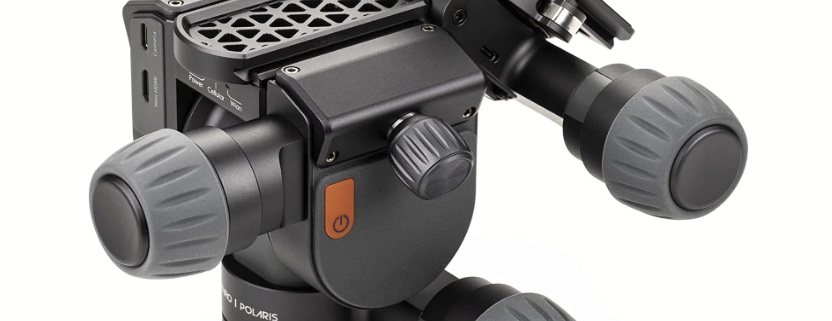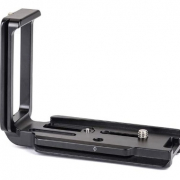Gear Review – Benro Polaris Astro 3-Axis Tripod Head
Someone got into my brain and designed my dream tripod head. As an astrolandscape, time-lapse, and deep-space photographer this new ,Benro Polaris Astro 3-Axis tripod head does all that I need and then some. This device tracks stars (with the Astro module), is a panning head for time-lapse, and much more including multi-row panoramas.
I will be specifically addressing the star tracking feature in this review. I will be reviewing the other features separately in a future post.
The Benro Polaris is a smart tripod head. It is capable of many functions and is available in 2 flavors. The Time-lapse Edition (2-axis) and the Astro Edition (3-axis) which is the Time-lapse Edition plus the Astro Module. It has a built-in rechargeable lithium battery.

Benro Polaris Tripod Head shown with Astro attachment.
Extremely well-built unit and very portable. Easy to configure with the app. There is no need to align with Polaris before tracking which is huge – especially when Polaris is behind a tree or cloud or building which makes alignment impossible. The built-in star catalog is decent and hopefully will be expanding and the GOTO works pretty well. This thing even does dithering*! It continues to track even when it is not connected to the app. You will need to restart the app to reconnect to the already tracking Polaris but it is pretty seamless.
I have the Move-Shoot-Move and also the Sky-Watcher Star Adventurer Astro Pack. This device is easier to configure than either one as you do not need to align it with Polaris. It also handles a heavier payload than either one which is helpful if you are using a heavy camera and lens combination. In the pecking order of these, my preference is the Benro Polaris, Move-Shoot-Move, and the Sky-Watcher (which I will now be selling). The Sky-Watcher is good but it is a large pain in the butt to align with Polaris. Move-Shoot-Move works very well, but can’t be aligned if Polaris is obscured by a cloud or building.
Does the Benro Polaris Astro have limitations? What doesn’t? This will not handle objects that are at the zenith (directly overhead). So, for long-duration tracking of objects that will cross the zenith it will fail to track, so keep that in mind. The Benro Polaris Astro will stop at 80 degrees so your sharp stars will become lovely star trails. As it is new, there are still some things that aren’t completely worked out yet but Benro has been great with fixing them and releasing updates.
If you are a photographer that shoots the Milky Way and deep-space objects this tripod head is amazing. If you currently use a tracker, the hardest part of using this device is letting go of the fact you don’t have to perform a polar alignment.
Here are 2 60-second exposures. One image is ISO 200, f/2, shot with a Nikon Z9 and Samyang 135mm lens. Yes, Jupiter is blown out and it is expected as planets are extremely bright. The second of Pleiades, ISO 125, Nikon Z9, and Nikon f/4.5 80-400mm lens. I flaked out and didn’t change the ISO from a prior shot but still, not bad! These were a test of the tracking. Each is a single frame from a series of 20 with a 5-second interval. Each subsequent shot was spot on. It didn’t drift. On the GOTO to Jupiter, I used the joystick in the app to center it. For the Pleiades, the GOTO nailed the center of the Pleiades on the first pass. These were shot on different nights so I am thinking that my tripod had a more perfect level when I shot the Pleiades. However, I don’t expect perfection with the GOTO but so far, it’s nothing I have complaints about. If it can get the object oriented within the camera frame, fine-tuning it is not a problem.

Benro Polaris Astro tracked, centered on Jupiter. Nikon Z9 with Samyang 135mm lens. ISO 200, f/2.0, 60 seconds. Single frame uncropped.

Benro Polaris Astro tracked, centered on the Pleiades. Nikon Z9 with Nikon 80-400mm lens @ 80mm. ISO 125, f/4.5, 60 seconds. Single frame slightly cropped in.
Below, is another image of the Orion nebula (M42). Stacked image comprised of 21 frames, not cropped. No dark or light frames were used. Nikon Z9 with Nikon 80-400mm lens @ 400mm. ISO 500, f/5.6, 30 seconds.

The Polaris App

(Benro Image)
The free app is available on Android and IOS. It connects quickly to the Polaris. Once connected, firmware updates can be applied to the tripod head. From the app, the shooting modes are accessible. Connected to the camera, the app provides live view as well as focus peaking, shutter release, and pretty much all the camera functions, including, ISO, shutter speed, aperture, and white balance. The Benro Polaris supports a wide range of cameras. Here’s their current ,list of cameras supported. I am very happy that every one of my Nikons is on this list. Many times a gadget supports one or two of my cameras but does not support the older cameras I have in my kit.
Here are examples of the app screens. These are screenshots I took from my tablet. Not all the steps are illustrated in this post, but it will provide insight into the functions available.
Selecting Astro will invoke a calibration screen. If the Astro module is not connected to the Benro Polaris, the Astro menu selection will be greyed out.

Calibration. This calibration of the phone/tablet to the Benro Polaris Astro provides the information the tripod head needs to properly align.

Once calibrated, you will see the following.

From this screen, you can search for an object and GOTO it. The items in green are the objects currently visible. The orange ones are not and you can’t select them.

Once an object is selected, the Benro Polaris Astro will slew to it.

Notes:
- Make sure you keep the firmware updated. This is handled via the mobile app.
- You have to have your tripod level before you mount the Polaris. This makes a big difference in the success of the GOTO.
- As you use your phone/tablet to calibrate the device for a night of shooting, make sure you point the arrow on the app in the right direction during calibration. The arrow displayed on the app needs to point opposite the direction of the lens.
- You will need a spacer if your tripod has a flat top plate as my Induro GIT-203 does. The ,Benro tripod spacer is what I use on this.
- A fully charged Benro Polaris works for many hours. For long-duration shoots, the battery can be supplemented by a power bank.
There isn’t a lot of info on the web regarding the setup of this amazing tripod head. It was the most difficult part of setting it up. Yes, it has a manual. Like most manuals, they aren’t wonderful. Trial and error and lots of misfires with alignment but now I have it down pat. I will be posting a detailed ,how-to to track stars in a future post.
I did a time-lapse test. I love the fact I can change exposure settings on the fly via the app. Critical for changing light conditions and holy grail time-lapse. I will review the time-lapse aspect of the Benro Polaris in a separate post.
Summary
What this head is not, is a telescope-grade GOTO mount. However, it has features from big brother telescope mounts that help photographers locate celestial objects and achieve very long exposures at low ISO and ultimately sharp stars. This helps in many ways. It speeds up locating a Messier or NGC object and the alignment of the camera. It also gives those not fluent in reading the night sky a kick start to learning it. Do you need GOTO ability to photograph the heavens? No. Does it make it easier and faster to get the shoot going? Most definitely.
I use an Android phone to connect to it. I understand some IOS users have issues with the app, but on Android 10 I did not encounter issues. I have tested it with another phone running Android 8.1 and also Android tablets running 8.1 and 12 as well, again with no issue.
The unit is not cheap. Given the various modes it has built into it, in my opinion, it isn’t outrageous.
I expect this to get better and better with each subsequent firmware and app update. Out of the gate, it is pretty damn good.
Not much amazes me. This thing sure does.
Below, is what comes in the box for the Astro configuration.

* In astrophotography, to dither means to shift the pointing of the telescope slightly in random directions between exposures. This allows hot and cold pixels, cosmic ray artifacts, and fixed pattern noise, and even satellite or airplane trails to be removed during the stacking process. ,Read more.
Do you currently use a tracker? What have been your challenges? Let’s hear it in the comments.
Disclosure: I purchased the Benro Polaris Astro. I have no affiliation with Benro. This review reflects my experience with it.
,Gear How-To Benro Polaris Astro Tripod Head and Polaris App
Taking photos and want to make them more compelling?
Art isn’t just for walls. Art is also to hold in one’s hands.
© Silvana Della Camera


 Silvana Della Camera
Silvana Della Camera

 Silvana Della Camera
Silvana Della Camera Silvana Della Camera
Silvana Della Camera


 Silvana Della Camera
Silvana Della Camera
Trackbacks & Pingbacks
[…] was slated to use a long lens on a gimbal, another camera with another long lens was to be set on a Benro Polaris which would track the Sun, and lastly, a hydrogen-alpha infrared converted camera also fitted with […]
[…] adjustment needed since the Sun moves so fast and quickly goes out of the frame. I will be using my Benro Polaris for the upcoming […]
[…] ,Gear Review: Benro Polaris Astro Tripod Head […]
[…] ,Gear Review: Benro Polaris Astro Tripod Head […]
[…] Full review of the Benro Polaris Astro 3-Axis Tripod Head […]
[…] Full review of the Benro Polaris Astro 3-Axis Tripod Head […]
Leave a Reply
Want to join the discussion?Feel free to contribute!